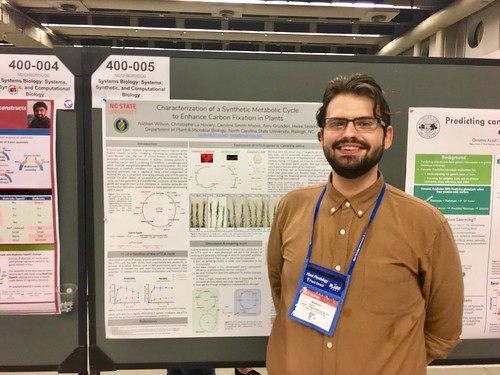International Symposium on Forest Tree Molecular Biology and Biotechnology Harbin, China July 24-26
Heike Sederoff (North Carolina State University, USA)
“Carbon fixation, metabolism and transport – potential new targets for engineering trees to increase biomass.”
American Society of Plant Biology Conference – Montreal July 14-18
Time to get ready for the ASPB meeting in Montreal. Find us there. https://www.eventscribe.com/2018/ASPB/PosterTitles.asp?pfp=PosterTitles
400-005 – Characterization of a Synthetic Metabolic Cycle to Enhance Carbon Fixation in Plants
Presenter: Nathan Wilson
Tuesday, Jul 17
1:30 PM – 3:00 PM
Ribulose-1,5-bisphosphate carboxylase/oxygenase (RuBisCO) is the catalytically “inefficient” enzyme of the Calvin-Benson cycle that is responsible for fixing atmospheric CO2 in plants. RuBisCO’s oxygenase activity causes as much as a 30% loss of fixed carbon and energy through photorespiration. This process diminishes plant productivity and is most detrimental in C3 crops, such as soybean and canola. It has been estimated that a 5% decrease of photorespiration would translate into a ~$540 million gain in annual crop production. Metabolic engineering approaches to design CO2 fixation cycles independent of RuBisCO have so far only been tested in vitro. We have engineered a synthetic CO2 fixation cycle inspired by bacterial autrotrophs. Our cycle is a condensed reverse Tricarboxylic Acid (crTCA) cycle which is modeled to achieve carbon fixation with a 20% lower energetic cost than the Calvin-Benson cycle. The crTCA cycle consists of 5 bacterial enzymes that utilize succinate and CO2 to generate glyoxylate and regenerate the carboxylation substrate. Based on successful in vitro analysis of the cycle, we have codon-optimized the bacterial genes for expression in plants. We have generated and have transformed constructs of those bacterial genes targeted to the chloroplast into Camelina sativa and have demonstrated stable expression. Preliminary analyses of crTCA lines show higher CO2assimilation rates and increased biomass. This suggests that the cycle can not only function but contributes to CO2 fixation in vivo. Our primary goals are to determine if supplementing RuBisCO via synthetic pathways is a viable approach to increasing plant productivity and to learn how this engineered pathway contributes to endogenous plant metabolism. This research was funded by the Department of Energy (ARPAe AR-0000207 & BER DE-SC0018269).
500-049 – Repression of the Cell Wall Invertase Inhibitors increase seed yield in Camelina sativa
Presenter: Brianne Edwards
Tuesday, Jul 17
1:30 PM – 3:00 PM
1000-071 – Evaluating components of the Common Symbiosis Pathway in nonmycorrhizal plants
Presenter: Eli Hornstein
Tuesday, July 17th
1:30 PM – 3:00 PM
Arbuscular mycorrhizae (AM) are central to rhizosphere relations in the large majority of plant species. Via its impact on nutrient uptake and stress resistance this symbiosis therefore also underlies patterns of wild species distribution and domestic agricultural productivity. However, the mechanisms that permit plants to recognize, accept, and regulate colonization by fungal symbionts are not yet fully understood. This study uses knock-in of the mycorrhizae-necessary gene Interacting Protein of DMI3 (IPD3) in the nonmycorrhizal oilseed crop Camelina sativa (Brassicaceae) to help address both the above questions and the issue of why a small minority of plant species have lost the ability to form mycorrhizae at all. IPD3 is a member of the Common Symbiosis Pathway (CSP) which enables fungal signals to be received by the plant and transduced into transcriptional changes of genes directly implicated in cell restructuring and nutrient exchange. Putative orthologs of 11 genes belonging to the CSP were identified in Camelina by protein sequence and structural similarity. In mycorrhizal host plants IPD3 is an inducible transcription factor at the center of the transduction chain comprising those 11 genes. In contrast to the other CSP elements with which it interacts, no putative ortholog of IPD3 was identified in Camelina. To begin determining whether any of the remaining CSP orthologs retain their symbiotic function, 7 lines of Camelina bearing the IPD3 coding sequence from Medicago truncatula were generated. Transgenic lines are currently being phenotyped for their response to exposure to the model AM fungus Rhizophagus irregularis. Transgenic lines will also be compared to wildtype Camelina and Medicago for relative expression changes of the interacting CSP genes before and after insertion of IPD3, and with and without exposure to the symbiont. This work is supported by BER grant DE-SC0018269.



